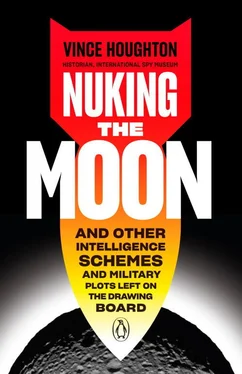Vince Houghton - Nuking the Moon - And Other Intelligence Schemes and Military Plots Left on the Drawing Board
Здесь есть возможность читать онлайн «Vince Houghton - Nuking the Moon - And Other Intelligence Schemes and Military Plots Left on the Drawing Board» весь текст электронной книги совершенно бесплатно (целиком полную версию без сокращений). В некоторых случаях можно слушать аудио, скачать через торрент в формате fb2 и присутствует краткое содержание. Город: New York, Год выпуска: 2019, ISBN: 2019, Издательство: Penguin Books, Жанр: История, Юмористические книги, на английском языке. Описание произведения, (предисловие) а так же отзывы посетителей доступны на портале библиотеки ЛибКат.
- Название:Nuking the Moon: And Other Intelligence Schemes and Military Plots Left on the Drawing Board
- Автор:
- Издательство:Penguin Books
- Жанр:
- Год:2019
- Город:New York
- ISBN:978-0-5255-0517-4
- Рейтинг книги:4 / 5. Голосов: 1
-
Избранное:Добавить в избранное
- Отзывы:
-
Ваша оценка:
- 80
- 1
- 2
- 3
- 4
- 5
Nuking the Moon: And Other Intelligence Schemes and Military Plots Left on the Drawing Board: краткое содержание, описание и аннотация
Предлагаем к чтению аннотацию, описание, краткое содержание или предисловие (зависит от того, что написал сам автор книги «Nuking the Moon: And Other Intelligence Schemes and Military Plots Left on the Drawing Board»). Если вы не нашли необходимую информацию о книге — напишите в комментариях, мы постараемся отыскать её.
Nuking the Moon: And Other Intelligence Schemes and Military Plots Left on the Drawing Board — читать онлайн бесплатно полную книгу (весь текст) целиком
Ниже представлен текст книги, разбитый по страницам. Система сохранения места последней прочитанной страницы, позволяет с удобством читать онлайн бесплатно книгу «Nuking the Moon: And Other Intelligence Schemes and Military Plots Left on the Drawing Board», без необходимости каждый раз заново искать на чём Вы остановились. Поставьте закладку, и сможете в любой момент перейти на страницу, на которой закончили чтение.
Интервал:
Закладка:
In the 1960s, the engineers working for American intelligence tried, in vain, to develop an artificial cochlea for use in covert listening devices. After a time, they realized that the technology of the day was inadequate for such an ambitious undertaking. And who can blame them? The cochlea is ridiculously complicated, so much so that we didn’t really understand its form and function until the late 1950s/early 1960s. Housed inside the cochlea is something called the basilar membrane, on which are found thousands upon thousands of hair cells, called stereocilia. The stereocilia at specific locations react to specific frequencies of sound. Low frequencies are picked up by certain hairs, while high frequencies stimulate others. This is why some people with mild hearing loss can no longer hear very high- or low-pitched sounds—the stereocilia for those particular frequencies have been damaged, but the rest of the cochlea is good to go.
Understandably, this level of complexity was beyond the capabilities of even the world’s greatest scientists and engineers of the 1960s—and the CIA had some of the very best, many of whom worked in a division that is today known as the Office of Technical Service (or OTS, at the time called the Technical Services Division, or TSD). Their unofficial motto: “Where a spy can be a kid again.” The intricacy of the cochlea is the result of millions of years of evolution, while inventors and engineers of the time had just finished perfecting the Etch A Sketch, felt-tips pens, AstroTurf, acrylic paint, and the audiocassette tape. We were still a couple of years away from the handheld calculator, electronic fuel injection for cars, and the first artificial heart (which, although way more important to us than the cochlea, is far less complicated). So give these guys a break. They did their best with what they had.
It’s at this point that some scientist in CIA’s TSD—unfortunately (for us) his name has been lost to history (perhaps fortunately for him)—decided to go in an entirely different direction. He said (and I’m paraphrasing), “This is stupid. Why are we killing ourselves trying to make an artificial cochlea for our listening devices? Why don’t we take something that already has a perfectly well-functioning cochlea, and turn it into a listening device?”
“Eureka, what a brilliant idea!” exclaimed his fellow CIA scientists. (Now, I am totally just making this conversation up—this is how it plays out in my historical imagination. Of course, it’s just as likely that his colleagues referred him to the CIA’s substance abuse program. But indulge me.) “But what animal should we use? A dog would be too conspicuous. Even the evil communists would stop to see if they could find the owner of a seemingly lost dog. A rat or squirrel would be shooed away before it could get close to any important conversation. Monkeys are easy to train, but who wouldn’t be suspicious if a random rhesus monkey walked up to you in the middle of a top-secret meeting? The only animal I know we shouldn’t try to use, because it would be impossible to train, is a cat.”
“A cat! That’s perfect!”
And on that day, Project Acoustic Kitty—that is actually the official title—was born. But we aren’t quite ready to tell the rest of the story. As you might suspect, my dramatic retelling of the decision-making process that birthed this project is extraordinarily unfair to the public servants who made up the TSD, the brains behind Acoustic Kitty. Along with the CIA’s Office of Research and Development (ORD), the scientists and engineers of TSD understood the very real potential usefulness of a feline secret agent. In many major cities, cats are ubiquitous. They come and go as they please, and no one thinks twice about a lone cat taking a stroll in a public park. Or even sliding through the gates of an embassy compound. It’s the perfect cover for a perfect clandestine operation.
But as we all know, cats can be persnickety. They tend to do whatever they want, when they want, and how they want, regardless of human pleading, soft cooing, bribery with treats, or even threats. Of course, the scientists and engineers at TSD and ORD understood this as well, but they had real reason to think that recent developments in brain science had paved the way for an attempt at the seemingly impossible. Part of this renaissance in neuroscience was a result of the natural progression of scientific discovery that defined the early to mid-twentieth century. This is a time in history where science was redefining our understanding of, well, everything.
Part of it was due to the CIA’s own in-house research. For the decade and a half leading up to Acoustic Kitty, the CIA had been pushing the envelope of what was “possible”—from applied science, to technology, to medical research, to even the parapsychological, much of this under the broad auspices of a program known as MKULTRA.
MKULTRA earned its well-deserved notoriety due to experiments in “mind control,” testing a bevy of hallucinogenic drugs, most notably LSD, on both witting and unwitting test subjects. Further criticism has been targeted at the program’s research and manufacture of what can only be described as biological and chemical weapons for CIA operational use in assassinations and other “executive actions.” But what many people don’t realize is that MKULTRA was actually multiple programs—about 150—under the single umbrella of the code name, and many of these subprojects had nothing to do with biological toxins, chemicals, or psychedelic drugs. Admittedly, we have no idea about most of the subprojects that made up MKULTRA. We only really know about a handful of them. The majority of the MKULTRA documents were (deliberately) destroyed decades ago, and unless someone kept a secret copy somewhere, we will never know the full extent of this particular chapter of the CIA’s history.
We do know that at least two of the subprojects centered on the use of electronic brain stimulation and the control of animals. According to a CIA report in late 1960, one of these, Subproject 94, demonstrated the “feasibility” of electronic implants and the behavioral manipulation of “several species” of animals. There is no specific mention of cats, but the results of the experiments were enough to spur on “development of future Agency applications.” One of these “applications” is the hero of our story, Acoustic Kitty.
Remember when I saidthere were two versions of this story? Up to this point, the stories are more or less the same. Here, however, is where the two Acoustic Kitty tales (no pun intended) begin to veer off in vastly different directions. We’ll take them one at a time, and then bring them back together at the end—which is, as far as anything that matters, essentially the same for both. The middle? Not so much.
The first version comes courtesy of Bob Wallace, who was the director of the OTS in the late 1990s and early 2000s. Bob briefly wrote about Acoustic Kitty in his book Spycraft, and even though I’ve read this book several times, [1] Bob is a member of the International Spy Museum’s Advisory Board. Spycraft is coauthored by Keith Melton, a member of the Museum’s Governing Board. You think I could get away with not knowing—and knowing really, really well—a book written by two of the museum’s board members? It’s required reading, but fortunately it’s a really great book.
I always try to get more out of him in person. On several occasions I’ve asked Bob about Acoustic Kitty, and his response is basically the same each time: a sardonic grin, a sly chuckle, and then a look of resigned acceptance when he realizes that I’m not just going to go away. Ultimately, I think Bob is willing to talk to me about Acoustic Kitty because he is an exceptionally nice person. I also think that Bob would much rather talk about some of the extraordinary accomplishments of TSS/TSD/OTS that I am not asking about. Things like the creation of hundreds, if not thousands, of espionage technologies that have helped American intelligence officers operate for decades all across the globe; or their integral part in the development of the U-2 spy plane, which first saw service in the 1950s, but was so revolutionary it still flies today; or their role in the rescue of six American diplomats from Tehran after the ouster of the shah (dramatized in the movie Argo ); or perhaps their work on secret communications, which allowed agents to operate in “denied areas” far behind the Iron Curtain and in East Asia. But I don’t want to talk about spy gadgets, secret aircraft, Ben Affleck, or invisible ink. I want to talk about cats.
Интервал:
Закладка:
Похожие книги на «Nuking the Moon: And Other Intelligence Schemes and Military Plots Left on the Drawing Board»
Представляем Вашему вниманию похожие книги на «Nuking the Moon: And Other Intelligence Schemes and Military Plots Left on the Drawing Board» списком для выбора. Мы отобрали схожую по названию и смыслу литературу в надежде предоставить читателям больше вариантов отыскать новые, интересные, ещё непрочитанные произведения.
Обсуждение, отзывы о книге «Nuking the Moon: And Other Intelligence Schemes and Military Plots Left on the Drawing Board» и просто собственные мнения читателей. Оставьте ваши комментарии, напишите, что Вы думаете о произведении, его смысле или главных героях. Укажите что конкретно понравилось, а что нет, и почему Вы так считаете.











